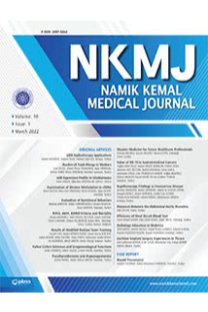Gastroenteropankreatik Nöroendokrin Tümörlerde Somatostatin Reseptörlerinin Önemi
nöroendokrin tümör, somatostatin reseptörü
UTILITY OF SOMATOSTATIN RECEPTORS IN GEP-NETs
somatostatin, neuroendocrine,
___
- 1. Massironi S, Conte D, Rossi RE. Somatostatin analogues in functioning gastroenteropancreatic neuroendocrine tumours: literature review, clinical recommendations and schedules. Scand J Gastroenterol 2016:51(5):513-523.
- 2. Modlin LM, Lye KD, Kidd M. A5 decade analysis of 13715 carcinoid tumors. Cancer 2003;97(4):934-959.
- 3. Rindi G, et al. Nomenclature and classification of neuroendocrine neoplasms of the digestive system. In: Bosman FT, Carneiro F, Hruban RH, Theise ND, eds. WHO Classification of Tumors of Digestive System. Lyon, France: International Agency for Research on Cancer (IARC) Press; 2010:13-14.
- 4. Raj N, Reidy-Lagunes D. Systemic therapies for advanced pancreatic neuroendocrine tumors. Hematol Oncol Clin North Am. 2016;30(1):119–33.
- 5. Hussein AM, Otrakji CL, Hussein BT. Small cell carcinoma of the stomach: case report and review of the literature. Dig Dis Sci. 1990;35:513-518.
- 6. Choi AB, Maxwell JE, Keck KJ,et al Is multifocality an indicator of aggressive behavior in small bowel neuroendocrine tumors? Pancreas 2017;46(9):1115-1120.
- 7. Gao Y, Gao H, Wang G, et al. A meta-analysis of prognostic factor of pancreatic neuroendocrine neoplasms. Sci Rep. 2018;8(7271):1–8. https://doi.org/10.1038/s41598-018-24072-0.
- 8. Moertel CG, Dockerty MB, Judd ES. Carcinoid tumors of the vermiform appendix. Cancer. 1968;21:270-278.
- 9. C. Fottner, M. Ferrata, and M. M. Weber, “Hormone secreting gastro-entero-pancreatic neuroendocrine neoplasias (GEP-NEN): when to consider, how to diagnose?,” Reviews in Endocrine and Metabolic Disorders, vol. 18, 2017.
- 10. Reubi JC, Laissue J, Waser B, et al. Expression of somatostatin receptors in normal, inflamed and neoplastic human gastrointestinal tissues. Ann N Y Acad Sci 1994;733:122-137.
- 11. Oberg KE, Reubi JC, Kwekkeboom DJ, et al. Role of somatostatins in gastroenteropancreatic neuroendocrine tumor development and therapy. Gastroenterology 2010;139:742-753.
- 12. Corleto VD, Nasoni S, Panzuto F, et al. Somatostatin receptor subtypes: basic pharmacology and tissue distribution. Dig Liver Dis 2004;36:s816.
- 13. Balaban CD, Severs WB. Cytotoxic effects of somatostatin in the cerebellum. Ann N Y Acad Sci 1992;656:802-810.
- 14. Bousquet C, Puente E, Buscail L, et al. Antiproliferative effect of somatostatin and analogs. Chemotherapy 2001;47:30-39.
- 15. Volante M, Brizzi MP, Faggiano A, Rosa S, Rapa I, Ferrero A, Mansueto G, Righi L, Garancini S, Capella C, De Rosa G, Dogliotti L, Colao A, Papotti M. Somatostatin receptor type 2A immunohistochemistry in neuroendocrine tumors: a proposal of scoring system correlated with somatostatin receptor scintigraphy. Modern Pathology (2007) 20, 1172–1182.
- 16. Mehta S, de Reuer PR, Gill P, et al. Somatostatin receptor SSTR2a expression is a stronger predictor for survival than Ki67 in pancreatic neuroendocrine tumors. Medicine 2015;94:e1281.
- 17. Strosberg J, Nasir A, Coppola D, et al. Correlation between grade and prognosis in metastatic gastroenteropancreatic neuroendocrine tumors. Hum Pathol 2009; 40:1262–8.
- 18. Herrera-Martinez AD, Gahete MD, Pedroza-Arevalo S, et al. Clinical and functional implication of the components of somatostatin system in gastroenteropancreatic neuroendocrine tumors. Endocrine 2018;59:426-437.
- 19. DeHerder WW, et al. Somatostatin receptors in gastroenteropancreatic neuroendocrine tumors. Endocr Relat Cancer 2003;10(4):451-458.
- 20. Sampedro-Nunez M, et al. Presence of SST5MD4 a truncated splice variant of the somatostatin receptor subtype 5 is associated to features of incerased aggressiveness in pancreatic neuroendocrine tumors. Oncotarget 2016;7(6):6593-6608.
- 21. Waser B, et al. Phosphorylation of SST2 receptors in neuroendocrine tumors after octreotide treatment of patients. Am J Pathol 2012;180(5):1942-1949.
- 22. Wang Y, Wang W, Jin K, et al. Somatostatin receptor expression indicates improved prognosis in gastroenteropancreatic neuroendocrine neoplasms and octreotide long-acting release is effective and safe in Chinese patients with advanced gastroneteropancreatic neuroendocrine tumors. Oncol Lett 2017;13:1165-1174.
- 23. Qian ZR, Li t, Ter-Minassian M, et al. Association between somatostatin receptor expression and clinical outcomes in neuroendocrine tumors. Pancreas 2016;45:1386-1393.
- 24. Clift AK, et al. Predicting the survival of patients with small bowel neuroendocrine tumors: comparison of 3 systems. Endocr Connect 2017;6(2):71-81.
- 25. Vinik AI, Silva MP, Woltering EA, et al. Biochemical testing for neuroendocrine tumors. Pancreas 2009;38:876-889.
- 26. Schurr PG, Strate T, Rese K, et al. Aggressive surgery improves long-term survival in neuroendocrine pancreatic tumors. Ann Surg. 2007;245(2):273–281. https://doi.org/10.1097/01.sla.00002 32556.24258.68.
- 27. Chan JA, Kulke MH. Progress in the treatment of neuroendocrine tumors. Curr Oncol Rep. 2009;11(3):193–9.
- 28. Rinke A, Muller HH, Schade-Brittinger C, Klose KJ, Barth P, Wied M, et al. Placebo-controlled, double-blind, prospective, randomized study on the effect of octreotide LAR in the control of tumor growth in patients with metastatic neuroendocrine midgut tumors: a report from the PROMID study group. J Clin Oncol. 2009;27(28):4656–63.
- 29. Caplin ME, Pavel M, Cwikla JB, Phan AT, Raderer M, Sedlackova E, et al. Lanreotide in metastatic enteropancreatic neuroendocrine tumors. N Engl J Med. 2014;371(3):224–33.
- ISSN: 2587-0262
- Yayın Aralığı: 4
- Başlangıç: 2013
- Yayıncı: Galenos Yayınevi
Murat AKGÜL, Çağrı DOĞAN, Cenk Murat YAZICI, Rıdvan ÖZCAN, Mehmet Fatih ŞAHİN
COVID-19 PANDEMİSİ ve TÜRKİYE'DE TIP EĞİTİMİ
Arda ÖZYÜKSEL, Baran ŞİMŞEK, Pelin KOCAPEHLİVAN, Şener DEMİROLUK, Murat SAYGI, Mehmet BİLAL
COVİD-19 Pandemi Döneminde Astım Tanılı Ergenlerde Anksiyete Düzeyinin Değerlendirilmesi
Nurşen CİĞERCİ GÜNAYDIN, Saliha BAYKAL
Opere Erken Evre Akciğer Kanseri Hastalarında Prognostik Faktörler Retrospektif Tek Merkez Sonuçları
Özkan ALAN, Özlem ERCELEP, Tugba AKİN, Eda TANRIKULU, Rahib HASANOV, Tugba BASOĞLU, Mehmet Akif ÖZTÜRK, Serap KAYA, Nalan AKGÜL, Tunç LAÇİN, Emine BOZKURTLAR, Faysal DANE, Perran YUMUK
LEUPROLİDE ASETAT TEDAVİSİ ALAN SANTRAL PUBERTE PREKOKS TANILI KIZ HASTALARDA UZUN DÖNEM SONUÇLAR
Esra ÖZMEN, Prof. Dr. Sibel TULGAR KINIK
